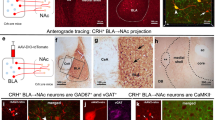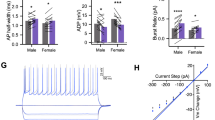Abstract
Environmental enrichment (EE) is known to have an anxiolytic effect in several animal models; however, the molecular mechanisms underlying these behavioral changes are not understood. In this study, we have shown that the anxiolytic effect of EE is associated with alterations in the corticotropin-releasing factor receptor type 1 (CRFR1) expression levels in the limbic system. We found that the decrease in anxiety-like behavior after housing in enriched conditions was associated with very low levels of CRFR1 mRNA expression in the basolateral amygdala of C57BL/6 mice. We further showed using a lentiviral-based system of RNA interference, that knockdown of CRFR1 mRNA expression in the basolateral amygdala induces a significant decrease in anxiety levels, similar to those achieved by EE nurture. Our data strongly suggest that reduced expression of CRFR1 mRNA levels in the basolateral amygdala mediates the effect of EE on anxiety-like behavior.
This is a preview of subscription content, access via your institution
Access options
Subscribe to this journal
Receive 12 print issues and online access
$259.00 per year
only $21.58 per issue
Buy this article
- Purchase on Springer Link
- Instant access to full article PDF
Prices may be subject to local taxes which are calculated during checkout





Similar content being viewed by others
References
Kessler RC, Berglund P, Demler O, Jin R, Merikangas KR, Walters EE . Lifetime prevalence and age-of-onset distributions of DSM-IV disorders in the National Comorbidity Survey Replication. Arch Gen Psychiatry 2005; 62: 593–602.
Alonso J, Lépine JP . Overview of key data from the European Study of the Epidemiology of Mental Disorders (ESEMeD). J Clin Psychiatry 2007; 68: 3–9.
Fox C, Merali Z, Harrison C . Therapeutic and protective effect of environmental enrichment against psychogenic and neurogenic stress. Behav Brain Res 2006; 175: 1–8.
Rozenzweig MR, Bennet EL, Hebert M, Morimoto H . Social grouping cannot account for cerebral effects of enriched environments. Brain Res 1978; 153: 563–576.
Hannan AJ . Huntington's disease: which drugs might help patients? IDrugs 2004; 7: 351–358.
McOmish CE, Hannan AJ . Enviromimetics: exploring gene-environment interactions to identify therapeutic targets for brain disorders. Expert Opin Ther Targets 2007; 11: 899–913.
Vale W, Spiess J, Rivier C, Rivier J . Characterization of a 41-residue ovine hypothalamic peptide that stimulates secretion of corticotropin and beta-endorphin. Science 1981; 213: 1394–1397.
Rivier C, Vale W . Modulation of stress-induced ACTH release by corticotropin releasing factor, catecholamines and vasopressin. Nature 1983; 305: 325–327.
Muglia L, Jacobson L, Dikkes P, Majzoub JA . Corticotropin-releasing hormone deficiency reveals major fetal but not adult glucocorticoid need. Nature 1995; 373: 427–432.
de Kloet ER, Joels M, Holsboer F . Stress and the brain: from adaptation to disease. Nat Rev Neurosci 2005; 6: 463–475.
McEwen BS . Glucocorticoids, depression, and mood disorders: structural remodeling in the brain. Metabolism 2005; 54: 20–23.
Zorrilla EP, Koob GF . The therapeutic potential of CRF1 antagonists for anxiety. Expert Opin Investig Drugs 2004; 137: 799–828.
Heinrichs SC, Koob GF . Corticotropin-releasing factor in brain: a role in activation, arousal, and affect regulation. J Pharmacol Exp Ther 2004; 311: 427–440.
Holsboer F . The rationale for corticotropin-releasing hormone receptor (CRH-R) antagonists to treat depression and anxiety. J Psychiatr Res 1999; 33: 181–214.
Arborelius L, Owens MJ, Plotsky PM, Nemeroff CB . The role of corticotropin-releasing factor in depression and anxiety disorders. J Endocrinol 1999; 160: 1–12.
Holmes A, Heilig M, Rupniak NM, Steckler T, Griebel G . Neuropeptide systems as novel therapeutic targets for depression and anxiety disorders. Trends Pharmacol Sci 2003; 24: 580–588.
Bale TL . Sensitivity to stress: dysregulation of CRF pathways and disease development. Horm Behav 2005; 48: 1–10.
Kuperman Y, Chen A . Urocortins: emerging metabolic and energy homeostasis perspectives. Trends Endocrinol Metabol 2008; 19: 122–129.
Smith GW, Aubry JM, Dellu F, Contarino A, Bilezikjian LM, Gold LH et al. Corticotropin releasing factor receptor 1-deficient mice display decreased anxiety, impaired stress response, and aberrant neuroendocrine development. Neuron 1998; 20: 1093–1102.
Timpl P, Spanagel R, Sillaber I, Kresse A, Reul JM, Stalla GK et al. Impaired stress response and reduced anxiety in mice lacking a functional corticotropin-releasing hormone receptor 1. Nat Genet 1998; 19: 162–166.
Müller MB, Zimmermann S, Sillaber I, Hagemeyer TP, Deussing JM, Timpl P et al. Limbic corticotropin-releasing hormone receptor type 1 mediates anxiety-related behavior and hormonal adaptation to stress. Nat Neurosci 2003; 6: 1100–1107.
Van Pett K, Viau V, Bittencourt JC, Chan RK, Li HY, Arias C et al. Distribution of mRNAs encoding CRF receptors in brain and pituitary of rat and mouse. J Comp Neurol 2000; 428: 191–212.
Justice NJ, Yuan ZF, Sawchenko PE, Vale W . Type 1 corticotropin-releasing factor receptor expression reported in BAC transgenic mice: implications for reconciling ligand-receptor mismatch in the central corticotropin-releasing factor system. J Comp Neurol 2008; 511: 479–496.
Sajdyk TJ, Shekhar A . Excitatory amino acid receptors in the basolateral amygdala regulate anxiety responses in the social interaction test. Brain Res 1997; 704: 262–264.
Sajdyk TJ, Shekhar A . Excitatory amino acid receptor antagonists block the cardiovascular and anxiety responses elicited by γ-aminobutyric acidA receptor blockade in the basolateral amygdala of rats. J Pharmacol Exp Ther 1997; 283: 969–977.
Sanders SK, Shekhar A . Anxiolytic effects of chlordiazepoxide blocked by injections of GABAA and benzodiazepine receptors antagonists in the region of the anterior basolateral amygdala of rats. Biol Psychiatry 1995; 37: 473–476.
Sanders SK, Shekhar A . Regulation of anxiety by GABAA receptors in the rat amygdala. Pharm Biochem Behav 1995; 52: 1–6.
Plakovits M . Punch sampling biopsy technique. Methods Enzymol 1983; 103: 368–376.
Tiscornia G, Singer O, Ikawa M, Verma IM . A general method for gene knockdown in mice by using lentiviral vectors expressing small interfering RNA. Proc Natl Acad Sci USA 2003; 100: 1844–1848.
Chapillon P, Manneche C, Belzung C, Caston J . Rearing environmental enrichment in two inbred strains of mice: 1. Effects on emotional reactivity. Behav Genet 1999; 29: 41–46.
Friske JE, Gammie SC . Environmental enrichment alters plus maze, but not maternal defense performance in mice. Physiol Behav 2005; 85: 187–194.
Benaroya-Milshtein N, Hollander N, Apter A, Kukulansky T, Raz N, Wilf A et al. Environmental enrichment in mice decreases anxiety, attenuates stress responses and enhances natural killer cell activity. Eur J Neurosci 2004; 20: 1341–1347.
Brenes Saenz JC, Villagra OR, Fornaguera Trias J . Factor analysis of forced swimming test, sucrose preference test and open field test on enriched, social and isolated reared rats. Behav Brain Res 2006; 169: 57–65.
Powell SB, Newman HA, McDonald TA, Bugenhagen P, Lewis MH . Development of spontaneous stereotyped behavior in deer mice: effects of early and late exposure to a more complex environment. Dev Psychobiol 2000; 37: 100–108.
Belz EE, Kennell JS, Czambel RK, Rubin RT, Rhodes ME . Environmental enrichment lowers stress-responsive hormones in singly housed male and female rats. Biochem Behav 2003; 76: 481–486.
Roy V, Belzung C, Delarue C, Chapillon P . Environmental enrichment in BALB/c mice: effects in classical tests of anxiety and exposure to a predatory odor. Physiol Behav 2001; 74: 313–320.
Francis DD, Diorio J, Plotsky PM, Meaney MJ . Environmental enrichment reverses the effects of maternal separation on stress reactivity. J Neurosci 2002; 22: 7840–7843.
Morley-Fletcher S, Rea M, Maccari S, Laviola G . Environmental enrichment during adolescence reverses the effects of prenatal stress on play behavior and HPA axis reactivity in rats. Eur J Neurosci 2003; 18: 3367–3374.
Marashi V, Barnekow A, Ossendorf E, Sachser N . Effects of different forms of environmental enrichment on behavioral, endocrinological, and immunological parameters in male mice. Horm Behav 2003; 43: 281–292.
Gray TS, Bingaman EW . The amygdala: corticotropin-releasing factor, steroids and stress. Crit Rev Neurobiol 1996; 10: 155–168.
Roozendaal B, Schelling G, McGaugh JL . Corticotropin-releasing factor in the basolateral amygdala enhances memory consolidation via an interaction with the beta-adrenoceptor-cAMP pathway: dependence on glucocorticoid receptor activation. J Neuorsci 2008; 28: 6642–6651.
Cohen H, Matar MA, Buskila D, Kaplan Z, Zohar J . Early post-stressor intervention with high-dose corticosterone attenuates posttraumatic stress response in an animal model of posttraumatic stress disorder. Biol Psychiatry 2008; 64: 708–717.
Nithianantharajah J, Hannan AJ . Enriched environments, experience-dependent plasticity and disorders of the nervous system. Nat Rev Neurosci 2006; 7: 697–709.
Mohammed AH, Henriksson BG, Söderström S, Ebendal T, Olsson T, Seckl JR . Environmental influences on the central nervous system and their implications for the aging rat. Behav Brain Res 1993; 57: 183–191.
Olsson T, Mohammed AH, Donaldson LF, Henriksson BG, Seckl JR . Glucocorticoid receptor and NGFI-A gene expression are induced in the hippocampus after environmental enrichment in adult rats. Brain Res Mol Brain Res 1994; 23: 349–353.
Larsson F, Winblad B, Mohammed AH . Psychological stress and environmental adaptation in enriched vs impoverished housed rats. Pharmacol Biochem Behav 2002; 73: 193–207.
Skelton KH, Nemeroff CB, Knight DL, Owens MJ . Chronic administration of the triazolobenzodiazepine Alprazolam produces opposite effects on corticotropin-releasing factor and urocortin neuronal systems. J Neurosci 2000; 20: 1240–1248.
Jochman KA, Newman SM, Kalin NH, Bakshi VP . Corticotropin-releasing factor-1 receptors in the basolateral amygdala mediate stress-induced anorexia. Behav Neurosci 2005; 119: 1448–1458.
Sajdyk TJ, Schober DA, Gehlert DR, Shekhar A . Role of corticotropin-releasing factor and urocortin within the basolateral amygdala of rats in anxiety and panic responses. Behav Brain Res 1999; 100: 207–215.
Spiga F, Lightman SL, Shekhar A, Lowry CA . Injections of urocortin 1 into the basolateral amygdala induce anxiety-like behavior and c-Fos expression in brainstem serotonergic neurons. Neuroscience 2006; 138: 1265–1276.
Gehlert DR, Shekhar A, Morin SM, Hipskind PA, Zink C, Gackenheimer SL et al. Stress and central urocortin increase anxiety-like behavior in the social interaction test via the CRF1 receptor. Eur J Pharmacol 2005; 509: 145–153.
Kempermann G, Kuhn HG, Gage FH . More hippocampal neurons in adult mice living in an enriched environment. Nature 1997; 386: 493–495.
Olsson IA, Sherwin CM . Behaviour of laboratory mice in different housing conditions when allowed to self-administer an anxiolytic. Lab Anim 2006; 40: 392–399.
Ziv Y, Ron N, Butovsky O, Landa G, Sudai E, Greenberg N et al. Immune cells contribute to the maintenance of neurogenesis and spatial learning abilities in adulthood. Nat Neurosci 2006; 9: 268–275.
Acknowledgements
AC is incumbent of the Philip Harris and Gerald Ronson Career Development Chair. This work is supported by research grants from the Israel Science Foundation; The National Institute for Psychobiology in Israel—founded by The Charles E. Smith Family; the Israel Ministry of Health; Roberto and Renata Ruhman; Mr and Mrs Mike Kahn; Mr Jorge David Ashkenazi; Mr and Mrs Barry Wolfe; and Nella and Leon Benoziyo Center for Neurosciences and Neurological Diseases.
Author information
Authors and Affiliations
Corresponding author
Ethics declarations
Competing interests
The authors declare no conflict of interest.
Rights and permissions
About this article
Cite this article
Sztainberg, Y., Kuperman, Y., Tsoory, M. et al. The anxiolytic effect of environmental enrichment is mediated via amygdalar CRF receptor type 1. Mol Psychiatry 15, 905–917 (2010). https://doi.org/10.1038/mp.2009.151
Received:
Revised:
Accepted:
Published:
Issue Date:
DOI: https://doi.org/10.1038/mp.2009.151
Keywords
This article is cited by
-
Structural Brain Patterns Associated with Traumatic Stress Resilience and Susceptibility to Mood and Anxiety Symptoms in Youths
Adversity and Resilience Science (2020)
-
Environmental enrichment induces behavioural disturbances in neuropeptide Y knockout mice
Scientific Reports (2016)
-
Region-specific roles of the corticotropin-releasing factor–urocortin system in stress
Nature Reviews Neuroscience (2016)
-
Neuroplasticity in response to cognitive behavior therapy for social anxiety disorder
Translational Psychiatry (2016)
-
Bidirectional rescue of extreme genetic predispositions to anxiety: impact of CRH receptor 1 as epigenetic plasticity gene in the amygdala
Translational Psychiatry (2014)



